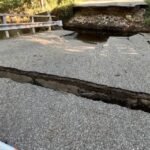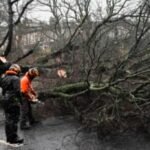In the quaint village of Lower Largo, a serene seaside scene was shattered as a vehicle was violently swept away by the merciless sea during the ferocious Storm Kathleen. This article delves into the harrowing event that left the Scottish community in shock.
The Fateful Day
As the storm raged, residents of Lower Largo witnessed an alarming sight—a grey car, once stationary on Main Street, began an unintended journey towards the Firth of Forth. The tempestuous tides, unrelenting and unforgiving, claimed the vehicle as their own. Onlookers could only watch in dismay as the car was consumed by the churning waters, its fate sealed by nature’s wrath.
The gap between The Crusoe hotel and its neighboring property, often a haven for parked cars, became the starting point of the vehicle’s perilous path. The paved space, leading to the beach, transformed into a treacherous trap as the storm intensified.

The vehicle’s descent was not just a spectacle of nature’s force but a stark reminder of the power of coastal storms. The waves, towering and tumultuous, battered the seafront buildings with such ferocity that the very foundations of the village were shaken.
The Aftermath
In the wake of the storm, the community of Lower Largo has been left to ponder the vulnerability of their picturesque locale. The incident has sparked conversations about the safety measures in place and the need for heightened awareness during such natural disasters.
The Scottish Environmental Protection Agency (SEPA) has been prompted to issue numerous flood alerts and warnings, urging residents to exercise caution. The agency’s flood duty manager emphasized the importance of preparedness and vigilance in the face of such unpredictable weather patterns.
As the village begins its recovery, the image of the car being swept away serves as a poignant symbol of the storm’s might and the impermanence of man-made constructs when pitted against the forces of nature.
Reflections and Warnings
Storm Kathleen has left an indelible mark on the community of Lower Largo, serving as a grim reminder of the fragility of life and property in the face of natural disasters. The event has raised questions about the adequacy of current weather warning systems and the steps that can be taken to prevent future tragedies.
The conversation has extended beyond the borders of the village, igniting a national dialogue on the impact of climate change and the increasing frequency of extreme weather events. It is a call to action for all, a plea for greater respect for the environment and a more proactive approach to safeguarding our communities.


















